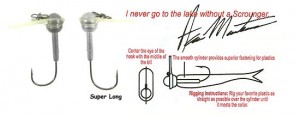Today, let’s look at another piece of terminal tackle that has become the “flavor of the month”, so to speak. The Davis Baits Aaron Martens Fish Swim Jig or scrounger head as it’s known. These jig heads are molded to accept a collar that is made of a flexible clear plastic that when retrieved will impart a subtle side to side motion on fluke style baits.
The purpose of using the scrounger head is so that you can fish it throughout the water column simply my changing the weight of the head. It has one, upward facing hook that allows it to get through hang-ups without fouling as much as more traditional pieces of terminal tackle. With this type of tool, it can be used where a depth specific crankbait wouldn’t be able to go due to other factors such as too much vegetation in the water or structure that would cause a crank to constantly get hung up.
Some folks like to use the Fish Swim Jig in front of paddle tail swimbaits to help them get deeper, faster and protect some of the softer versions from taking the kind of damage that they are susceptible to. So what kind of action can you expect from the scrounger head?
Scrounger Head Action
The wiggle is so subtle that it can be difficult to see when it’s in the water using anything other than a paddle tail. When you’re using a split tail bait, the side to side shimmy is almost imperceptible especially if you were to pair the jig head with a hollow body split tail. This is the application we used when we first started experimenting with the scrounger head. I was not impressed with the scrounger in this situation.
However, it does seem to add something to paddle style swimbaits. It changes the frequency of the swimming action and makes them a bit nose heavy. I really don’t know that this is necessarily a good thing. The jury is still out whether or not this characteristic produced more or less bites in our testing.
Another way to fish with this piece of terminal tackle is to let it sink to the bottom and drag it as opposed to jigging it. This seems to be the best application for the Fish Swim Jig. The scrounger when used like this, will kick up mud, silt and sand from the bottom and seems to elicit some reaction strikes when used in conjunction with fluke style baits. In our testing this method produced more positive results than any other that we tried.
The Collar
One of the things that occurred to me while we were testing the scrounger head is that although the collar is clear, it is something that the fish can easily see as they approach your lure. For pressured fish, it is reasonable to assume that this can be a deterrent to getting bites other than in optimal conditions.
Be Careful While Casting
The other attribute that surprised us is that casting with the scrounger head was more difficult than we would have guessed. The collar on the Fish Swim Jig has a lot of resistance in the air and will certainly spin on the cast. This will affect both your distance and accuracy negatively. Couple that with a swimbait or a fluke style bait on the business end of the scrounger and it really requires a lot more concentration to put your lure where you want it than some might be comfortable with.
In the final analysis, we found that the only application that we were happy with the Fish Swim Jig was the dragging method with a fluke style bait. Other than that, there are several other ways to accomplish the depth control and action that the scrounger was designed for without having to deal with either the collar or the snap that are integral parts of the Davis offering.
| Aaron Martin's Scrounger Head | |
|---|---|
| Overall Rating | |
| Not quite sure what all the fuss is about | |
See ya’ on the water …
